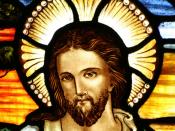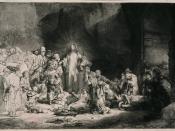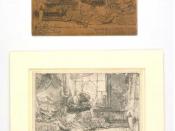The prominent printing technique of the seventeenth century is a process known as etching. An etching needle is used to draw into a wax ground applied over a metal plate. The plate is then submerged in a series of acid baths, each biting into the metal surface only where unprotected by the ground. The ground is removed, ink is forced into the etched depressions, the unetched surfaces wiped, and an impression is printed. Also, both the design etched on a plate and an impression made from an etched plate. This process was taken by storm when artists found that etching was more manageable than engraving. Etching offered the greatest subtlety of line and tone.
Another example of etching from the seventeenth century is Jacques Callott's Hanging Tree, from the series entitled the Miseries of War. Callott focused mainly on etching and widely influenced artists who would later pursue this medium.
His study of the art led to discoveries of developing hard, smooth surfaces for copper plates as well as creating very precise lines with etching needles. His detail and vivid drawing produced panoramas that were true to life, as if they were black and white images from his mind. Hanging Tree is a realistic pictorial record of the tragedy of human conflict.
Although known for painting, Rembrandt also utilized etching. Prints became a major source of income. One of Rembrandt's most remembered etchings is Christ with the Sick Around Him, Receiving the Children. This print is suffused with a deep and abiding piety. Christ appears in the central preaching to those with various afflictions. This image is about Christian humility, mercy, and compassion. With etching, he demonstrates his great use of light and shadow, which is typical of Baroque art. This print also demonstrates an interpretation of the Protestant...


